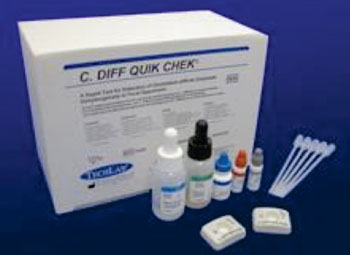Stability of Fecal Specimens for Bacterial Diagnostics Investigated
|
By LabMedica International staff writers Posted on 23 Oct 2014 |

Image: Culture of Clostridium difficile from a stool sample after 24 hours of incubation on chromogenic medium forming typical black colonies (Photo courtesy of the Freeman Hospital).

Image: The C.DIFF QUIK CHEK kit for the diagnosis of Clostridium difficile (Photo courtesy of TECHLAB).
To test for Clostridium difficile in stool specimens transported from remote geographic locations is a challenge due to long transit times, often at room temperature.
Discrepancies in C. difficile detection rates using nucleic acid amplification tests (NAAT) and antigen, culture and cytopathic effect (CPE) tests have been reported which may be due differences in the load of organisms in the stool, sometimes very low in asymptomatic carriage, and determining the viable count for C. difficile may be needed to differentiate between asymptomatic colonization versus true disease.
Microbiologists at the St. Boniface Research Center (Winnipeg, MB, Canada) assessed the impact of storage at room temperature versus 4 °C for up to 72 hours on the stability of glutamate dehydrogenase antigen, Toxin A and B antigens, toxigenic culture and cytopathic effect testing. Twelve diagnostic stool samples that were tested on the day of collection and shown to be C. difficile toxin positive were used for this study. Sample aliquots of each stool were stored at room temperature and 4 °C and testing was repeated at 24, 48 and 72 hours.
Stools that were positive for the presence of glutamate dehydrogenase (GD) using the C.DIFF QUIK CHEK kit (TECHLAB; Blacksburg, VA, USA) and also positive for the presence of Toxin A/Toxin B when tested by TECHLAB’s TOX A/B QUIK CHEK kit were included in the study. Cytopathic effect (CPE) tests were conducted using Human Foreskin Fibroblast cells (Inter Medico; Markham, ON, Canada). The pellet from the sample used for the CPE test were processed and used to inoculate Clostridium difficile moxalactam norfloxacin (CDMN) agar (Oxoid Company; Nepean, ON, Canada). The glutamate dehyrdogenase antigen and toxigenic stool culture tests were shown to be 100% reproducible at room temperature and 4 °C for up to 72 hours. Toxin A and B antigen deteriorated to 70% by 72 hours at room temperature, but was 90% reproducible if held at 4 °C. The cytopathic effect assay was 90% reproducible by 72 hours at room temperature and 4 °C.
The authors concluded that if stool samples are held at room temperature, the Toxin A/B antigen testing is only stable for 48 hours and by 72 hours is only 70% sensitive. They recommended that for stool samples received from remote geographic locations where transport is at room temperature and may be up to 72 hours, a combination of GD antigen screening combined with NAAT is used to ensure optimal sensitivity. The study was published on June 30, 2014, in the Journal of Medical Microbiology & Diagnosis.
Related Links:
St. Boniface Research Center
TECHLAB
Inter Medico
Discrepancies in C. difficile detection rates using nucleic acid amplification tests (NAAT) and antigen, culture and cytopathic effect (CPE) tests have been reported which may be due differences in the load of organisms in the stool, sometimes very low in asymptomatic carriage, and determining the viable count for C. difficile may be needed to differentiate between asymptomatic colonization versus true disease.
Microbiologists at the St. Boniface Research Center (Winnipeg, MB, Canada) assessed the impact of storage at room temperature versus 4 °C for up to 72 hours on the stability of glutamate dehydrogenase antigen, Toxin A and B antigens, toxigenic culture and cytopathic effect testing. Twelve diagnostic stool samples that were tested on the day of collection and shown to be C. difficile toxin positive were used for this study. Sample aliquots of each stool were stored at room temperature and 4 °C and testing was repeated at 24, 48 and 72 hours.
Stools that were positive for the presence of glutamate dehydrogenase (GD) using the C.DIFF QUIK CHEK kit (TECHLAB; Blacksburg, VA, USA) and also positive for the presence of Toxin A/Toxin B when tested by TECHLAB’s TOX A/B QUIK CHEK kit were included in the study. Cytopathic effect (CPE) tests were conducted using Human Foreskin Fibroblast cells (Inter Medico; Markham, ON, Canada). The pellet from the sample used for the CPE test were processed and used to inoculate Clostridium difficile moxalactam norfloxacin (CDMN) agar (Oxoid Company; Nepean, ON, Canada). The glutamate dehyrdogenase antigen and toxigenic stool culture tests were shown to be 100% reproducible at room temperature and 4 °C for up to 72 hours. Toxin A and B antigen deteriorated to 70% by 72 hours at room temperature, but was 90% reproducible if held at 4 °C. The cytopathic effect assay was 90% reproducible by 72 hours at room temperature and 4 °C.
The authors concluded that if stool samples are held at room temperature, the Toxin A/B antigen testing is only stable for 48 hours and by 72 hours is only 70% sensitive. They recommended that for stool samples received from remote geographic locations where transport is at room temperature and may be up to 72 hours, a combination of GD antigen screening combined with NAAT is used to ensure optimal sensitivity. The study was published on June 30, 2014, in the Journal of Medical Microbiology & Diagnosis.
Related Links:
St. Boniface Research Center
TECHLAB
Inter Medico
Latest Microbiology News
- Handheld Device Deliver Low-Cost TB Results in Less Than One Hour
- New AI-Based Method Improves Diagnosis of Drug-Resistant Infections
- Breakthrough Diagnostic Technology Identifies Bacterial Infections with Almost 100% Accuracy within Three Hours
- Innovative ID/AST System to Help Diagnose Infectious Diseases and Combat AMR
- Gastrointestinal Panel Delivers Rapid Detection of Five Common Bacterial Pathogens for Outpatient Use
- Rapid PCR Testing in ICU Improves Antibiotic Stewardship
- Unique Genetic Signature Predicts Drug Resistance in Bacteria
- Unique Barcoding System Tracks Pneumonia-Causing Bacteria as They Infect Blood Stream
- Rapid Sepsis Diagnostic Test Demonstrates Improved Patient Care and Cost Savings in Hospital Application
- Rapid Diagnostic System to Detect Neonatal Sepsis Within Hours
- Novel Test to Diagnose Bacterial Pneumonia Directly from Whole Blood
- Interferon-γ Release Assay Effective in Patients with COPD Complicated with Pulmonary Tuberculosis
- New Point of Care Tests to Help Reduce Overuse of Antibiotics
- 30-Minute Sepsis Test Differentiates Bacterial Infections, Viral Infections, and Noninfectious Disease
- CRISPR-TB Blood Test to Enable Early Disease Diagnosis and Public Screening
- Syndromic Panel Provides Fast Answers for Outpatient Diagnosis of Gastrointestinal Conditions
Channels
Clinical Chemistry
view channel
Carbon Nanotubes Help Build Highly Accurate Sensors for Continuous Health Monitoring
Current sensors can measure various health indicators, such as blood glucose levels, in the body. However, there is a need to develop more accurate and sensitive sensor materials that can detect lower... Read more
Paper-Based Device Boosts HIV Test Accuracy from Dried Blood Samples
In regions where access to clinics for routine blood tests presents financial and logistical obstacles, HIV patients are increasingly able to collect and send a drop of blood using paper-based devices... Read moreMolecular Diagnostics
view channel
RNA-Based Blood Test Detects Preeclampsia Risk Months Before Symptoms
Preeclampsia remains a major cause of maternal morbidity and mortality, as well as preterm births. Despite current guidelines that aim to identify pregnant women at increased risk of preeclampsia using... Read more
First Of Its Kind Test Uses microRNAs to Predict Toxicity from Cancer Therapy
Many men with early-stage prostate cancer receive stereotactic body radiotherapy (SBRT), a highly precise form of radiation treatment that is completed in just five sessions. Compared to traditional radiation,... Read moreNovel Cell-Based Assay Provides Sensitive and Specific Autoantibody Detection in Demyelination
Anti-myelin-associated glycoprotein (MAG) antibodies serve as markers for an autoimmune demyelinating disorder that affects the peripheral nervous system, leading to sensory impairment. Anti-MAG-IgM antibodies... Read moreHematology
view channel
New Scoring System Predicts Risk of Developing Cancer from Common Blood Disorder
Clonal cytopenia of undetermined significance (CCUS) is a blood disorder commonly found in older adults, characterized by mutations in blood cells and a low blood count, but without any obvious cause or... Read more
Non-Invasive Prenatal Test for Fetal RhD Status Demonstrates 100% Accuracy
In the United States, approximately 15% of pregnant individuals are RhD-negative. However, in about 40% of these cases, the fetus is also RhD-negative, making the administration of RhoGAM unnecessary.... Read moreImmunology
view channel
Stem Cell Test Predicts Treatment Outcome for Patients with Platinum-Resistant Ovarian Cancer
Epithelial ovarian cancer frequently responds to chemotherapy initially, but eventually, the tumor develops resistance to the therapy, leading to regrowth. This resistance is partially due to the activation... Read more
Machine Learning-Enabled Blood Test Predicts Immunotherapy Response in Lymphoma Patients
Chimeric antigen receptor (CAR) T-cell therapy has emerged as one of the most promising recent developments in the treatment of blood cancers. However, over half of non-Hodgkin lymphoma (NHL) patients... Read morePathology
view channel
Advanced Imaging Reveals Mechanisms Causing Autoimmune Disease
Myasthenia gravis, an autoimmune disease, leads to muscle weakness that can affect a range of muscles, including those needed for basic actions like blinking, smiling, or moving. Researchers have long... Read more
AI Model Effectively Predicts Patient Outcomes in Common Lung Cancer Type
Lung adenocarcinoma, the most common form of non-small cell lung cancer (NSCLC), typically adopts one of six distinct growth patterns, often combining multiple patterns within a single tumor.... Read moreTechnology
view channel
Pain-On-A-Chip Microfluidic Device Determines Types of Chronic Pain from Blood Samples
Chronic pain is a widespread condition that remains difficult to manage, and existing clinical methods for its treatment rely largely on self-reporting, which can be subjective and especially problematic... Read more
Innovative, Label-Free Ratiometric Fluorosensor Enables More Sensitive Viral RNA Detection
Viruses present a major global health risk, as demonstrated by recent pandemics, making early detection and identification essential for preventing new outbreaks. While traditional detection methods are... Read moreIndustry
view channel
Cepheid and Oxford Nanopore Technologies Partner on Advancing Automated Sequencing-Based Solutions
Cepheid (Sunnyvale, CA, USA), a leading molecular diagnostics company, and Oxford Nanopore Technologies (Oxford, UK), the company behind a new generation of sequencing-based molecular analysis technologies,... Read more
Grifols and Tecan’s IBL Collaborate on Advanced Biomarker Panels
Grifols (Barcelona, Spain), one of the world’s leading producers of plasma-derived medicines and innovative diagnostic solutions, is expanding its offer in clinical diagnostics through a strategic partnership... Read more























